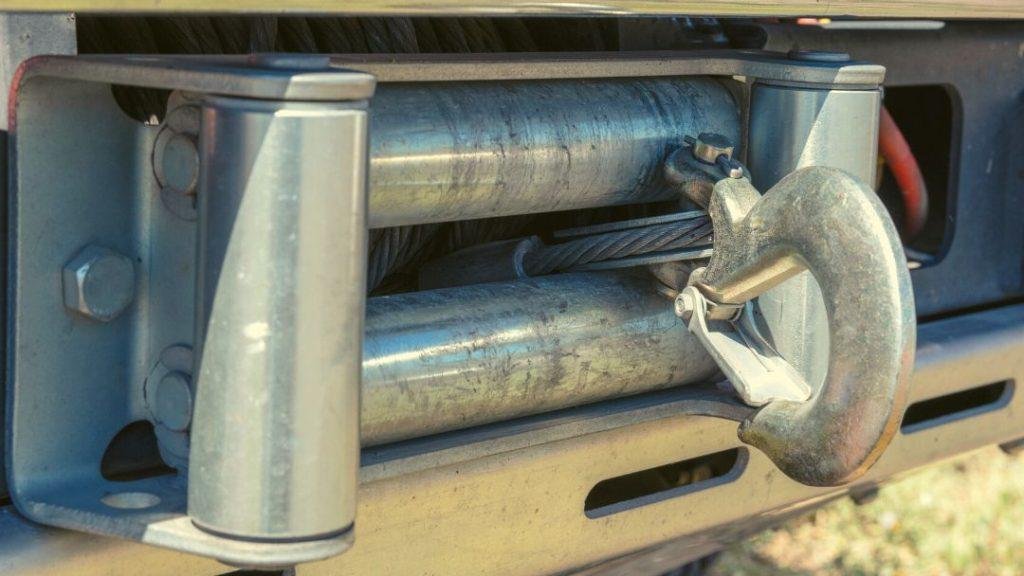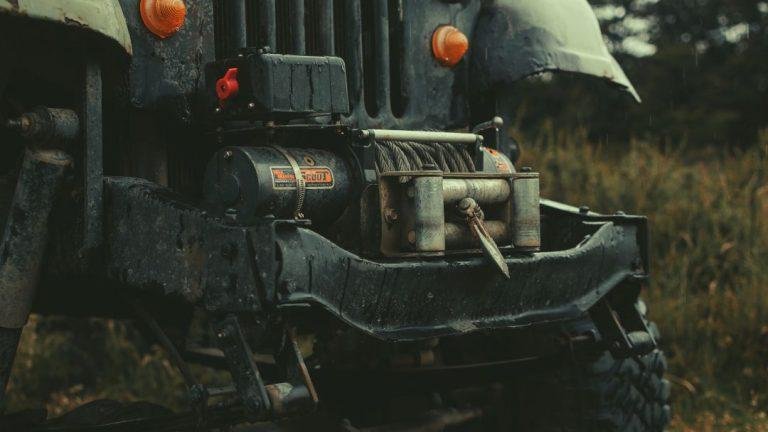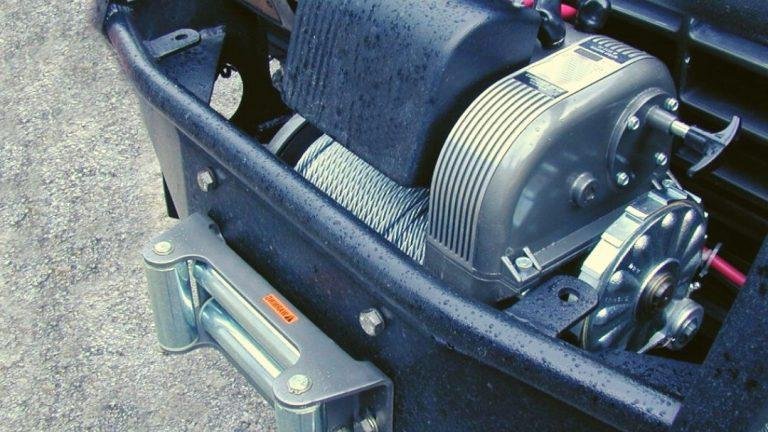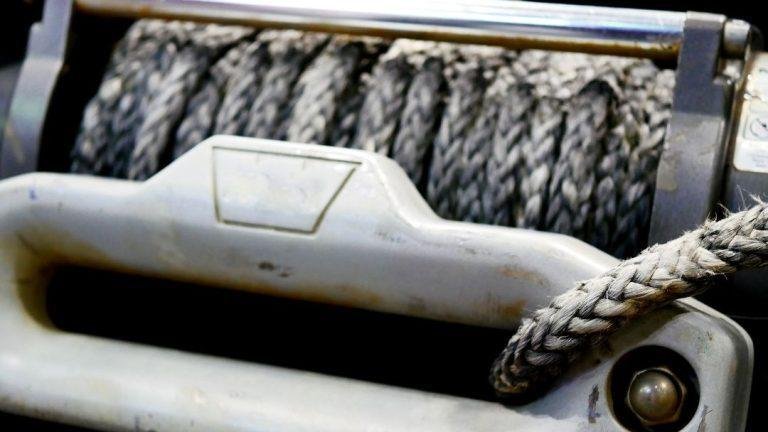A winch fairlead guides the rope or cable of a winch, preventing it from getting tangled and ensuring smooth operation. It acts as a protective barrier between the winch and the object being pulled, reducing friction and allowing for controlled movement.
Winch fairleads are commonly used in off-road vehicles and industrial applications, providing stability and reliability during challenging towing or recovery operations. By positioning the rope in the correct alignment, a winch fairlead enhances the winch’s pulling capacity and minimizes the risk of damage.
Whether on a remote trail or in a demanding work environment, a winch fairlead plays a crucial role in optimizing the efficiency and effectiveness of a winching system.
Understanding The Purpose And Function
A winch fairlead is an integral part of a winching system, designed to guide the winch cable and prevent it from getting damaged during operation. It ensures smooth and safe winching, protecting both the cable and the winch. Understanding its purpose and function is crucial for efficient winch usage.
Definition And Basic Concept Of A Winch Fairlead:
A winch fairlead is a crucial component of a winching system that plays a vital role in ensuring a smooth and efficient operation. It is a device designed to guide the winch cable or rope, preventing it from chafing against the winch drum or other sharp edges during the winching process.
The primary purpose of a winch fairlead is to minimize friction and improve the overall performance of the winch by ensuring a straight and controlled deployment of the cable or rope. Here are some key points to understand about winch fairleads:
- The winch fairlead is typically made of durable materials like steel or aluminum, which can withstand high tension and resist damage caused by rough terrain or abrasive surfaces.
- It consists of a mounting plate or frame that secures the fairlead to the front of the vehicle or any other desired location.
- The fairlead is designed with either a roller or a hawse configuration, depending on the specific winching requirements and the type of winch being used.
- In a roller fairlead, a series of rollers are positioned to guide the cable or rope smoothly onto and off the winch drum, reducing friction and preventing excessive wear.
- A hawse fairlead, on the other hand, features a smooth, contoured surface that allows the cable or rope to slide across easily with minimal friction.
The winch fairlead is an essential component that helps optimize the performance and durability of a winch, allowing for efficient and safe winching operations.
How A Winch Fairlead Enhances Winching Capabilities:
A winch fairlead not only protects the winch cable or rope from damage but also enhances the capabilities of the winching process. By providing a secure and controlled path for the cable or rope, a winch fairlead offers several benefits that contribute to successful winching.
Here are some key ways in which a winch fairlead enhances winching capabilities:
- Facilitates straight pulling: The fairlead ensures that the cable or rope deploys and retracts in a straight line, allowing for optimized pulling power and reducing the risk of tangling or snags.
- Reduces friction: By minimizing friction between the cable or rope and the winch drum or other abrasive surfaces, the fairlead helps prevent wear and tear, extending the lifespan of the winch components.
- Prevents cable damages: The fairlead’s roller or hawse design prevents the cable from rubbing against sharp edges or rough surfaces, reducing the chances of fraying, kinking, or breaking during winching.
- Enhances winching precision: With the cable or rope smoothly guided by the fairlead, operators have better control over the winch, allowing for precise positioning and controlled pulling power.
- Offers versatility: Winch fairleads are available in various configurations to suit different winching applications and cable diameters, ensuring compatibility and flexibility for various types of winches.
By improving the overall functionality and safety of the winching process, a winch fairlead enables users to tackle tough recovery tasks with ease and confidence.
Explaining The Hidden Power Behind A Winch Fairlead:
While the significance of a winch fairlead may not be immediately apparent, it possesses hidden power that enhances the efficiency and effectiveness of winching operations. Understanding the inherent advantages of a winch fairlead shed light on the indispensable role it plays.
Consider the following points:
- Friction reduction: By minimizing friction between the winch cable or rope and the winch drum or external surfaces, a winch fairlead prevents unnecessary resistance and reduces stress on the winch motor. This friction reduction translates into more efficient winching, reducing strain on the vehicle’s electrical system and extending the life of the winch.
- Cable protection: A winch fairlead shields the cable or rope from sharp edges, abrasive surfaces, and potential obstructions. It prevents the cable from becoming entangled in debris, reducing the risk of damage such as kinking, fraying, or compromising the cable’s integrity.
- Increased durability: With proper cable guidance and protection, a winch fairlead ensures the cable remains intact and capable of withstanding the immense forces involved in winching. This enhances the overall durability and reliability of the winch system, enabling it to perform optimally even under challenging conditions.
- Enhanced control and safety: The winch fairlead’s ability to guide the cable or rope in a controlled and predictable manner empowers operators with improved control during winching operations. This facilitates precise movements, accurate positioning, and a higher level of safety for both the operator and the surrounding environment.
- Compatibility and adaptability: Winch fairleads are available in different designs, such as roller fairleads and hawse fairleads, allowing users to select the most suitable option based on their specific winching requirements. This compatibility ensures seamless integration with various winch models and applications, enhancing versatility and adaptability.
The hidden power of a winch fairlead lies in its ability to optimize winching performance, protect vital components, improve control, and ensure the durability of the winch system. By choosing the right winch fairlead and employing it effectively, operators can maximize the potential of their winch and undertake winching tasks with utmost confidence.
Incorporating these points, you now possess a comprehensive understanding of the definition, function, and hidden power behind a winch fairlead.

Comparing The Options For Optimal Performance
Winch fairleads play a crucial role in achieving optimal winch performance. They guide the cable smoothly onto the winch drum, preventing tangles and improving overall efficiency. By comparing different options, you can choose the right fairlead for enhanced winching capabilities.
Roller Fairleads: Advantages And Disadvantages
- Roller fairleads are commonly used in winch installations and offer several advantages:
- Provide smooth and efficient operation by minimizing friction between the fairlead and the winch cable or rope.
- Distribute the load evenly across multiple rollers, reducing wear and tear on the cable or rope.
- Ideal for heavy-duty applications where durability and reliability are crucial.
- Suitable for both synthetic ropes and steel cables.
- Can withstand harsh conditions and environmental factors.
- Despite their benefits, roller fairleads also have a few drawbacks:
- More expensive compared to other fairlead options.
- The rollers can accumulate dirt and debris over time, requiring regular cleaning and maintenance.
- Bulkier and heavier than hawse fairleads, which can impact the overall weight of the winch setup.
- May not be suitable for off-roading and other applications that require a lower profile fairlead design.
Hawse Fairleads: Pros And Cons
- Hawse fairleads, also known as aluminum fairleads, have gained popularity in recent years due to their unique features:
- Lightweight and compact design, making them a preferred choice for off-road enthusiasts and light-duty applications.
- Offer great versatility as they can accommodate synthetic ropes effectively.
- Less prone to dirt and debris accumulation compared to roller fairleads due to their sleek and flush surface.
- Ideal for vehicles with limited space for mounting a fairlead due to their low profile.
- Generally more affordable than roller fairleads, making them a cost-effective option.
- However, hawse fairleads also have some limitations:
- Not suitable for winches using steel cables, as they can cause premature wear and potential damage.
- May experience increased friction, which can lead to heat buildup when used with steel cables.
- Less durable than roller fairleads in heavy-duty or extreme conditions.
- Greater risk of damage in situations where impact or contact occurs.
Synthetic Rope Vs Steel Cable: Factors To Consider In Fairlead Selection
When selecting a fairlead for your winch, it’s essential to consider the type of rope or cable you’ll be using. Here are the crucial factors to evaluate:
Synthetic Rope:
- Offers several advantages over traditional steel cables:
- Lightweight and easier to handle, reducing strain on the winch motor and overall vehicle weight.
- Floats on water, making it suitable for water recovery operations.
- Safer to handle, as it won’t produce dangerous recoil if it snaps under extreme tension.
- Flexible and less prone to kinking or tangling, ensuring smooth and efficient winching.
- Requires a fairlead with a larger opening or chamfered edges to prevent abrasion and fraying.
- Does not rust or corrode, providing long-lasting performance.
- May require periodic inspection for signs of wear and tear.
Steel Cable:
- Still widely used and offers its own set of benefits:
- High tensile strength, making it suitable for heavy-duty applications and winching heavier loads.
- Resistant to sharp edges and rough surfaces, reducing the risk of abrasion and damage.
- Generally more affordable compared to synthetic ropes.
- Requires a fairlead with rollers to prevent the cable from binding or bunching up.
- Prone to rust and corrosion, necessitating regular maintenance and lubrication.
- Heavyweight and can be hazardous if it snaps under extreme tension.
- More rigid and can be challenging to handle, potentially causing kinks and tangles.
Selecting the right fairlead for your winch requires careful consideration of factors such as your specific needs, application, budget, and the type of rope or cable you’ll be using. Whether you opt for roller fairleads or hawse fairleads, it’s crucial to ensure compatibility with your chosen rope or cable to achieve optimal winching performance.
Key Considerations For Maximum Efficiency
The winch fairlead plays an essential role in maximizing efficiency during pulling operations. It guides the wire rope to prevent tangling and ensure smooth movement, increasing the overall performance of the winch system.
Matching The Fairlead To The Winch And Vehicle Requirements
- Consider the type of winch you have and the specific requirements of your vehicle to ensure the fairlead is compatible.
- Check the winch specifications for information on the recommended fairlead type.
- Look for a fairlead that matches the winch drum size and shape to ensure smooth operation.
- Take into account whether your winch is intended for off-road use or for lighter tasks, as this will influence fairlead selection.
- Choose a fairlead that is compatible with the vehicle’s mounting location and setup.
Evaluating The Load Capacity And Line Speed Compatibility
- Determine the maximum load capacity of your winch and ensure that the fairlead can handle that weight.
- Consider the line speed of your winch and choose a fairlead that can accommodate the speed without causing friction or damage to the line.
- Look for fairleads that have a design that reduces heat buildup during high-speed pulls, preventing premature wear and tear.
- Keep in mind that certain fairleads are better suited for heavy-duty winches, while others are more suitable for lighter loads.
Assessing The Terrain And Environmental Factors For Fairlead Selection
- Evaluate the type of terrain you frequently encounter to determine the appropriate fairlead material.
- For rocky or abrasive terrain, consider a fairlead made of durable materials like steel or aluminum, which can withstand impact and reduce wear on the winch line.
- In sandy or muddy conditions, opt for a fairlead with a smooth surface to prevent the buildup of debris and ensure smooth operation.
- Consider the environmental factors, such as exposure to saltwater or extreme temperatures, and choose a fairlead that is resistant to corrosion or freezing.
- Keep in mind that fairleads with rollers offer smooth line retrieval, while hawse fairleads provide a reliable option for synthetic winch lines.
By considering these key factors, you can ensure that your winch fairlead is matched to your winch and vehicle requirements, while also taking into account load capacity, line speed compatibility, and the specific conditions in which it will be used.
Doing so will maximize the efficiency and longevity of your winching operations, allowing you to tackle tough terrains and demanding situations with confidence.
Ensuring Longevity And Optimal Performance
A winch fairlead plays a crucial role in ensuring the longevity and optimal performance of your winch. It guides the cable properly, reducing friction and preventing damage, allowing for smooth and efficient operation.
A winch fairlead plays a crucial role in the proper functioning of your winch. It serves as a guide for the synthetic or steel cable, preventing it from getting damaged or tangled during operation. Taking care of your winch fairlead is essential to ensure its longevity and optimal performance.
This section will provide you with a step-by-step guide for installing a winch fairlead, regular maintenance practices for prolonging its lifespan, and troubleshooting tips for common issues.
Step-By-Step Guide For Installing A Winch Fairlead:
- Begin by securing the winch onto a suitable mounting location on your vehicle, using the appropriate bolts and hardware.
- Identify the appropriate position on your winch where the fairlead will be attached.
- Attach the winch fairlead to the designated spot using the provided bolts, ensuring it is securely fastened.
- Depending on the type of fairlead you have (roller or hawse), align the cable with the fairlead rollers or through the fairlead opening.
- Carefully thread the winch cable through the fairlead, making sure it is properly seated and aligned.
- Continue routing the cable according to your winch manufacturer’s instructions, ensuring it is correctly spooled onto the winch drum.
- Test the winch to ensure smooth operation and proper cable alignment.
Regular Maintenance Practices For Prolonging Fairlead Lifespan:
- Keep the fairlead clean by regularly washing it with mild soap and water, especially after off-road adventures or extreme weather conditions.
- Inspect the fairlead for any signs of damage, such as cracks, chips, or corrosion. Replace it immediately if any issues are detected.
- Lubricate the fairlead regularly with a suitable lubricant to reduce friction and ensure smooth cable movement.
- Check the winch cable for any wear or fraying. Replace it if necessary, as a damaged cable can cause premature wear on the fairlead.
- Store your winch with the cable properly spooled onto the drum to avoid unnecessary strain on the fairlead.
Troubleshooting Common Issues With Winch Fairleads:
- If the winch cable feels stuck or is not retracting smoothly, check for any debris, dirt, or obstructions in the fairlead. Clean it thoroughly to ensure proper cable movement.
- In case of a damaged fairlead roller, replace it as soon as possible to prevent further damage to the winch cable.
- If the fairlead is not aligned correctly, it can cause the cable to bind or become tangled. Adjust the fairlead positioning to resolve this issue.
- Excessive friction between the cable and fairlead can lead to overheating. Lubricate the fairlead properly to reduce friction and avoid this problem.
- If the fairlead is showing signs of wear or deterioration, consider upgrading to a more durable and long-lasting fairlead.
By following these installation, maintenance, and troubleshooting tips, you can ensure the longevity and optimal performance of your winch fairlead. Regular care and attention will keep your winching endeavors smooth and hassle-free, allowing you to tackle any off-road challenges with confidence.
Amplifying The Hidden Power Of Your Winch
Discover the hidden potential of your winch with the help of a winch fairlead. Enhance its capabilities and achieve optimal performance with this essential accessory.
Understanding How Winch Fairleads Increase Winch Efficiency:
- Winch fairleads are designed to guide the winch cable properly, reducing friction and wear on the winch rope.
- They prevent the winch rope from tangling or binding, allowing the winch to operate smoothly and efficiently.
- Winch fairleads ensure optimal alignment of the cable, minimizing strain on the winch motor and increasing its lifespan.
Exploring Advanced Techniques For Leveraging Maximum Power:
- Selecting the right type of fairlead for your winch can significantly improve its pulling capacity and overall performance.
- By using roller fairleads, the winch rope is able to roll smoothly, reducing resistance and enabling maximum power output.
- Cable management techniques like spooling the winch rope evenly and ensuring proper tension can enhance power transfer and increase winching capabilities.
Real-Life Examples And Success Stories Of Winch Fairlead Application:
- Off-road enthusiasts have experienced the benefits of winch fairleads firsthand, particularly in challenging terrain and recovery situations.
- Winch fairleads have proven instrumental in safely extracting vehicles stuck in mud, sand, or snow, even in the most demanding conditions.
- Many professional recovery teams rely on winch fairleads for reliable and efficient winching, highlighting their effectiveness in real-life scenarios.
Frequently Asked Questions For What Does Winch Fairlead Do
What Is The Purpose Of The Roller Fairlead?
The purpose of the roller fairlead is to guide the winch cable in a smooth and controlled manner. It prevents the cable from becoming twisted or damaged during the winching process. The roller fairlead consists of a series of rotating rollers that allow the cable to move freely as it is being pulled in or out.
It is especially useful when the winch is used at sharp angles or when there is a need for lateral movement. The roller fairlead ensures that the cable is properly aligned and reduces friction, thereby improving the overall efficiency and longevity of the winching system.
It is an essential component for anyone using a winch for activities such as off-roading, recovery operations, or industrial applications.
Can You Use Synthetic Winch Rope With Roller Fairlead?
Yes, you can use synthetic winch rope with a roller fairlead. Synthetic winch ropes are compatible with different fairleads, including roller fairleads. The roller fairlead allows the synthetic rope to slide smoothly during operation, reducing friction and ensuring efficient winching.
Synthetic winch ropes offer several advantages over steel cables, such as being lighter, stronger, and safer to handle. They are also less prone to rust and are easier to store. However, it is important to note that when using synthetic winch rope with a roller fairlead, regular maintenance and inspection should be conducted to ensure its optimal performance and to identify any signs of wear and tear.
This will help maintain the safety and longevity of the winch system.
Do You Need Aluminum Fairlead For Synthetic Rope?
Yes, you need an aluminum fairlead for synthetic rope. Aluminum fairleads are recommended because synthetic rope has different properties than traditional steel cables. Synthetic ropes are lighter, more flexible, and have less stretch. Aluminum fairleads are designed to prevent damage to the synthetic rope by reducing friction and wear.
They provide a smooth surface for the rope to glide over during winching operations. Using a steel fairlead with synthetic rope can cause excessive heat and wear, leading to potential failure. Therefore, it is important to use an aluminum fairlead specifically designed for synthetic ropes to ensure optimal performance and longevity.
Is Rope Or Cable Better On A Winch?
Rope or cable is used on a winch based on specific needs. Rope provides flexibility, easier handling, and lighter weight, making it a popular choice for off-road enthusiasts. It is less likely to cause injuries if it breaks and is less prone to kinking.
Cable, on the other hand, is sturdier and can withstand heavier loads and abrasions. It is commonly used in industries like construction and towing. Ultimately, the choice depends on factors such as the intended use, the weight of the load, and personal preferences.
Both rope and cable have their advantages, so it is important to consider these factors before deciding which is better for your winch application.
Conclusion
In a nutshell, the winch fairlead plays a crucial role in maximizing the effectiveness and durability of your winch system. By guiding the wire rope and minimizing friction as it winds and unwinds, a winch fairlead ensures smooth operation and prevents premature wear.
This integral component not only safeguards your winch from damage but also protects your vehicle by reducing the risk of slippage or overloading. Whether you’re an off-road enthusiast, a utility worker, or an avid outdoorsman, understanding the importance of a winch fairlead is key to ensuring safe and successful recoveries.
So, next time you’re considering adding or upgrading your winch, don’t overlook the significance of a high-quality winch fairlead. Its ability to optimize your winch’s performance and extend its lifespan is worth every consideration. Get equipped with the right winch fairlead today and take your adventures to new heights!





